Ji Ma
Like Playing a Video Game: Spatial-Temporal Optimization of Foot Trajectories for Controlled Football Kicking in Bipedal Robots
Oct 02, 2025Abstract:Humanoid robot soccer presents several challenges, particularly in maintaining system stability during aggressive kicking motions while achieving precise ball trajectory control. Current solutions, whether traditional position-based control methods or reinforcement learning (RL) approaches, exhibit significant limitations. Model predictive control (MPC) is a prevalent approach for ordinary quadruped and biped robots. While MPC has demonstrated advantages in legged robots, existing studies often oversimplify the leg swing progress, relying merely on simple trajectory interpolation methods. This severely constrains the foot's environmental interaction capability, hindering tasks such as ball kicking. This study innovatively adapts the spatial-temporal trajectory planning method, which has been successful in drone applications, to bipedal robotic systems. The proposed approach autonomously generates foot trajectories that satisfy constraints on target kicking position, velocity, and acceleration while simultaneously optimizing swing phase duration. Experimental results demonstrate that the optimized trajectories closely mimic human kicking behavior, featuring a backswing motion. Simulation and hardware experiments confirm the algorithm's efficiency, with trajectory planning times under 1 ms, and its reliability, achieving nearly 100 % task completion accuracy when the soccer goal is within the range of -90{\deg} to 90{\deg}.
Steering Prosocial AI Agents: Computational Basis of LLM's Decision Making in Social Simulation
Apr 16, 2025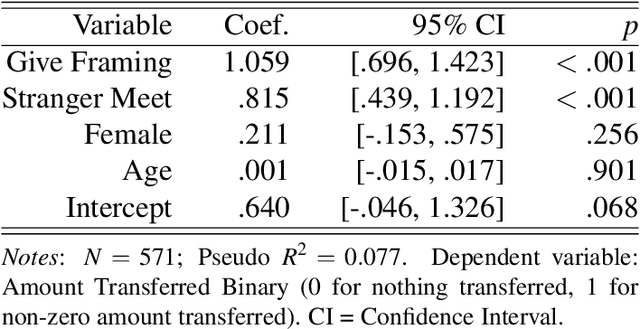
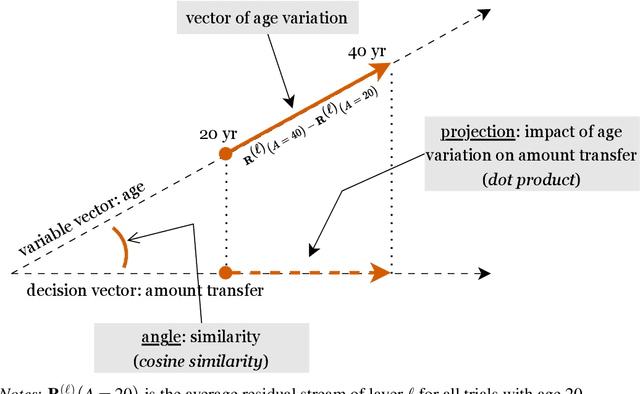
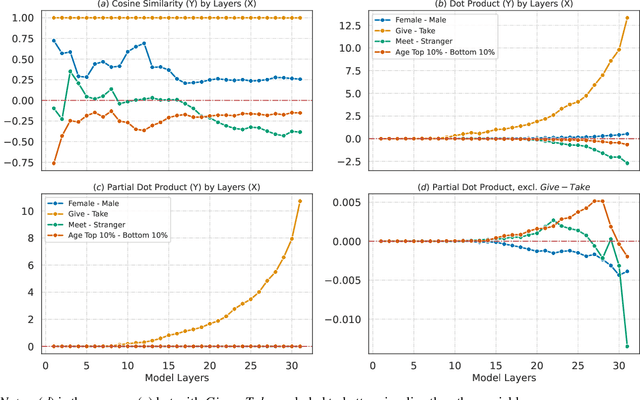
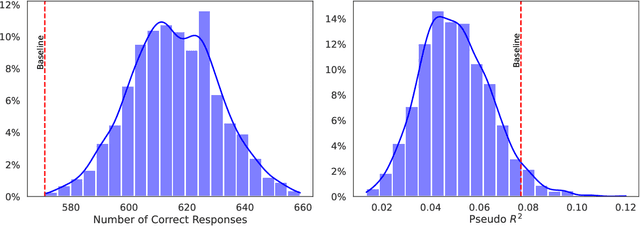
Abstract:Large language models (LLMs) increasingly serve as human-like decision-making agents in social science and applied settings. These LLM-agents are typically assigned human-like characters and placed in real-life contexts. However, how these characters and contexts shape an LLM's behavior remains underexplored. This study proposes and tests methods for probing, quantifying, and modifying an LLM's internal representations in a Dictator Game -- a classic behavioral experiment on fairness and prosocial behavior. We extract ``vectors of variable variations'' (e.g., ``male'' to ``female'') from the LLM's internal state. Manipulating these vectors during the model's inference can substantially alter how those variables relate to the model's decision-making. This approach offers a principled way to study and regulate how social concepts can be encoded and engineered within transformer-based models, with implications for alignment, debiasing, and designing AI agents for social simulations in both academic and commercial applications.
A Unified Theoretic and Algorithmic Framework for Solving Multivariate Linear Model with $\ell^1$-norm Optimization
Apr 01, 2025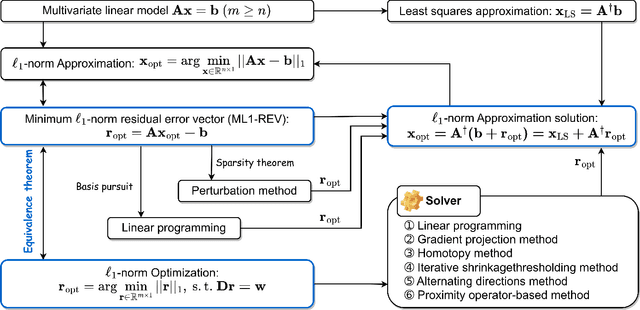
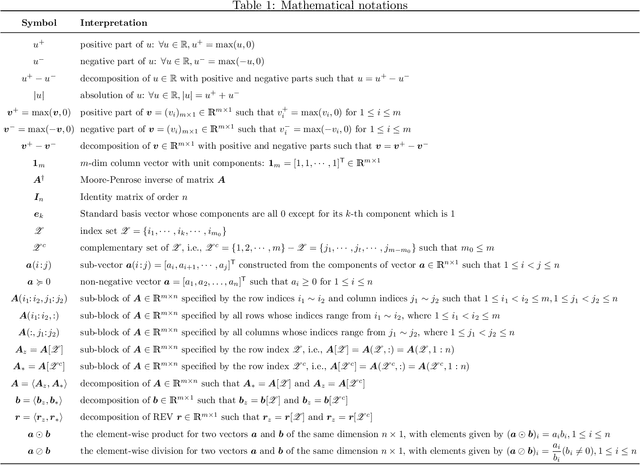
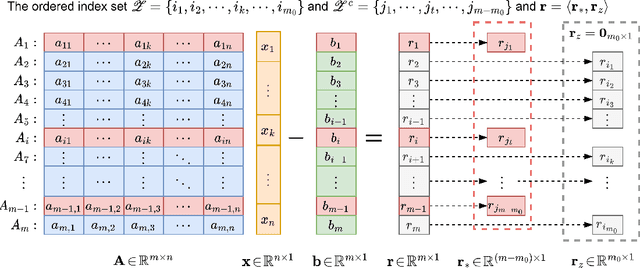
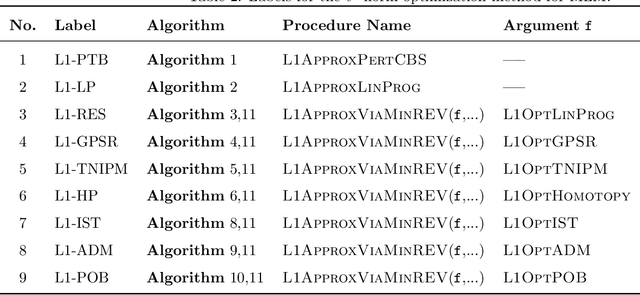
Abstract:It is a challenging problem that solving the \textit{multivariate linear model} (MLM) $\mathbf{A}\mathbf{x}=\mathbf{b}$ with the $\ell_1 $-norm approximation method such that $||\mathbf{A}\mathbf{x}-\mathbf{b}||_1$, the $\ell_1$-norm of the \textit{residual error vector} (REV), is minimized. In this work, our contributions lie in two aspects: firstly, the equivalence theorem for the structure of the $\ell_1$-norm optimal solution to the MLM is proposed and proved; secondly, a unified algorithmic framework for solving the MLM with $\ell_1$-norm optimization is proposed and six novel algorithms (L1-GPRS, L1-TNIPM, L1-HP, L1-IST, L1-ADM, L1-POB) are designed. There are three significant characteristics in the algorithms discussed: they are implemented with simple matrix operations which do not depend on specific optimization solvers; they are described with algorithmic pseudo-codes and implemented with Python and Octave/MATLAB which means easy usage; and the high accuracy and efficiency of our six new algorithms can be achieved successfully in the scenarios with different levels of data redundancy. We hope that the unified theoretic and algorithmic framework with source code released on GitHub could motivate the applications of the $\ell_1$-norm optimization for parameter estimation of MLM arising in science, technology, engineering, mathematics, economics, and so on.
Learning an Adaptive Fall Recovery Controller for Quadrupeds on Complex Terrains
Dec 22, 2024Abstract:Legged robots have shown promise in locomotion complex environments, but recovery from falls on challenging terrains remains a significant hurdle. This paper presents an Adaptive Fall Recovery (AFR) controller for quadrupedal robots on challenging terrains such as rocky, breams, steep slopes, and irregular stones. We leverage deep reinforcement learning to train the AFR, which can adapt to a wide range of terrain geometries and physical properties. Our method demonstrates improvements over existing approaches, showing promising results in recovery scenarios on challenging terrains. We trained our method in Isaac Gym using the Go1 and directly transferred it to several mainstream quadrupedal platforms, such as Spot and ANYmal. Additionally, we validated the controller's effectiveness in Gazebo. Our results indicate that the AFR controller generalizes well to complex terrains and outperforms baseline methods in terms of success rate and recovery speed.
Memory-Reduced Meta-Learning with Guaranteed Convergence
Dec 16, 2024



Abstract:The optimization-based meta-learning approach is gaining increased traction because of its unique ability to quickly adapt to a new task using only small amounts of data. However, existing optimization-based meta-learning approaches, such as MAML, ANIL and their variants, generally employ backpropagation for upper-level gradient estimation, which requires using historical lower-level parameters/gradients and thus increases computational and memory overhead in each iteration. In this paper, we propose a meta-learning algorithm that can avoid using historical parameters/gradients and significantly reduce memory costs in each iteration compared to existing optimization-based meta-learning approaches. In addition to memory reduction, we prove that our proposed algorithm converges sublinearly with the iteration number of upper-level optimization, and the convergence error decays sublinearly with the batch size of sampled tasks. In the specific case in terms of deterministic meta-learning, we also prove that our proposed algorithm converges to an exact solution. Moreover, we quantify that the computational complexity of the algorithm is on the order of $\mathcal{O}(\epsilon^{-1})$, which matches existing convergence results on meta-learning even without using any historical parameters/gradients. Experimental results on meta-learning benchmarks confirm the efficacy of our proposed algorithm.
Pruning All-Rounder: Rethinking and Improving Inference Efficiency for Large Vision Language Models
Dec 09, 2024



Abstract:Although Large Vision-Language Models (LVLMs) have achieved impressive results, their high computational cost poses a significant barrier to wider application. To enhance inference efficiency, most existing approaches depend on parameter-dependent or token-dependent strategies to reduce computational demands. However, these methods typically require complex training processes and struggle to consistently select the most relevant tokens. In this paper, we systematically analyze the above challenges and provide a series of valuable insights for inference acceleration. Based on these findings, we propose a novel framework, the Pruning All-Rounder (PAR). Different from previous works, PAR develops a meta-router to adaptively organize pruning flows across both tokens and layers. With a self-supervised learning manner, our method achieves a superior balance between performance and efficiency. Notably, PAR is highly flexible, offering multiple pruning versions to address a range of pruning scenarios. The code for this work will be made publicly available.
Can Machines Think Like Humans? A Behavioral Evaluation of LLM-Agents in Dictator Games
Oct 28, 2024Abstract:As Large Language Model (LLM)-based agents increasingly undertake real-world tasks and engage with human society, how well do we understand their behaviors? This study (1) investigates how LLM agents' prosocial behaviors -- a fundamental social norm -- can be induced by different personas and benchmarked against human behaviors; and (2) introduces a behavioral approach to evaluate the performance of LLM agents in complex decision-making scenarios. We explored how different personas and experimental framings affect these AI agents' altruistic behavior in dictator games and compared their behaviors within the same LLM family, across various families, and with human behaviors. Our findings reveal substantial variations and inconsistencies among LLMs and notable differences compared to human behaviors. Merely assigning a human-like identity to LLMs does not produce human-like behaviors. Despite being trained on extensive human-generated data, these AI agents cannot accurately predict human decisions. LLM agents are not able to capture the internal processes of human decision-making, and their alignment with human behavior is highly variable and dependent on specific model architectures and prompt formulations; even worse, such dependence does not follow a clear pattern.
Content-decoupled Contrastive Learning-based Implicit Degradation Modeling for Blind Image Super-Resolution
Aug 10, 2024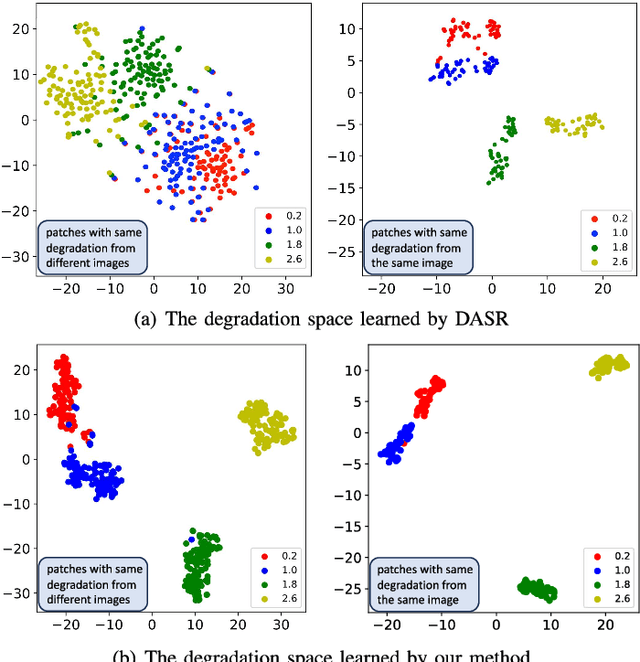
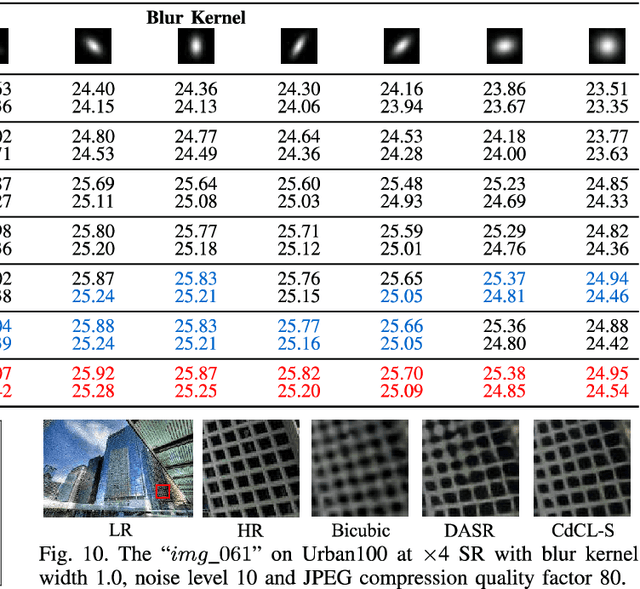
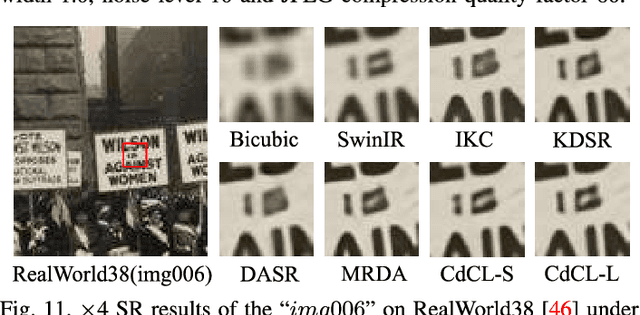
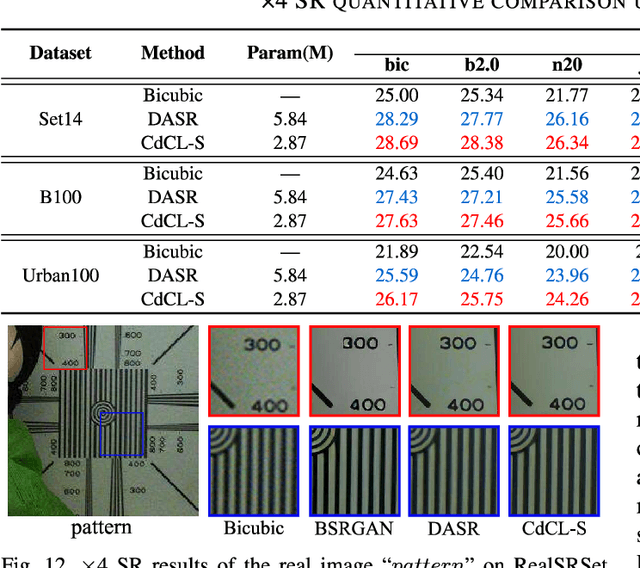
Abstract:Implicit degradation modeling-based blind super-resolution (SR) has attracted more increasing attention in the community due to its excellent generalization to complex degradation scenarios and wide application range. How to extract more discriminative degradation representations and fully adapt them to specific image features is the key to this task. In this paper, we propose a new Content-decoupled Contrastive Learning-based blind image super-resolution (CdCL) framework following the typical blind SR pipeline. This framework introduces negative-free contrastive learning technique for the first time to model the implicit degradation representation, in which a new cyclic shift sampling strategy is designed to ensure decoupling between content features and degradation features from the data perspective, thereby improving the purity and discriminability of the learned implicit degradation space. In addition, to improve the efficiency and effectiveness of implicit degradation-based blind super-resolving, we design a detail-aware implicit degradation adaption module with lower complexity, which adapts degradation information to the specific LR image from both channel and spatial perspectives. Extensive experiments on synthetic and real data prove that the proposed CdCL comprehensively improves the quantitative and qualitative results of contrastive learning-based implicit blind SR paradigm, and achieves SOTA PSNR in this field. Even if the number of parameters is halved, our method still achieves very competitive results.
AHMF: Adaptive Hybrid-Memory-Fusion Model for Driver Attention Prediction
Jul 24, 2024



Abstract:Accurate driver attention prediction can serve as a critical reference for intelligent vehicles in understanding traffic scenes and making informed driving decisions. Though existing studies on driver attention prediction improved performance by incorporating advanced saliency detection techniques, they overlooked the opportunity to achieve human-inspired prediction by analyzing driving tasks from a cognitive science perspective. During driving, drivers' working memory and long-term memory play crucial roles in scene comprehension and experience retrieval, respectively. Together, they form situational awareness, facilitating drivers to quickly understand the current traffic situation and make optimal decisions based on past driving experiences. To explicitly integrate these two types of memory, this paper proposes an Adaptive Hybrid-Memory-Fusion (AHMF) driver attention prediction model to achieve more human-like predictions. Specifically, the model first encodes information about specific hazardous stimuli in the current scene to form working memories. Then, it adaptively retrieves similar situational experiences from the long-term memory for final prediction. Utilizing domain adaptation techniques, the model performs parallel training across multiple datasets, thereby enriching the accumulated driving experience within the long-term memory module. Compared to existing models, our model demonstrates significant improvements across various metrics on multiple public datasets, proving the effectiveness of integrating hybrid memories in driver attention prediction.
CAMON: Cooperative Agents for Multi-Object Navigation with LLM-based Conversations
Jun 30, 2024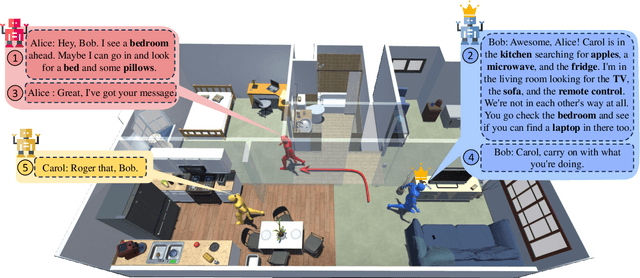
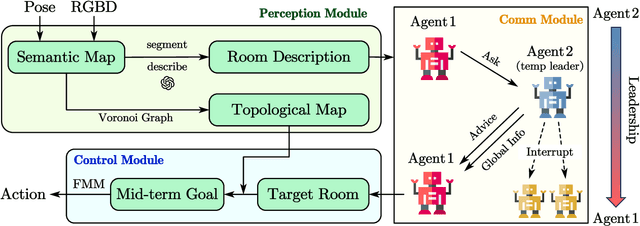
Abstract:Visual navigation tasks are critical for household service robots. As these tasks become increasingly complex, effective communication and collaboration among multiple robots become imperative to ensure successful completion. In recent years, large language models (LLMs) have exhibited remarkable comprehension and planning abilities in the context of embodied agents. However, their application in household scenarios, specifically in the use of multiple agents collaborating to complete complex navigation tasks through communication, remains unexplored. Therefore, this paper proposes a framework for decentralized multi-agent navigation, leveraging LLM-enabled communication and collaboration. By designing the communication-triggered dynamic leadership organization structure, we achieve faster team consensus with fewer communication instances, leading to better navigation effectiveness and collaborative exploration efficiency. With the proposed novel communication scheme, our framework promises to be conflict-free and robust in multi-object navigation tasks, even when there is a surge in team size.
 Add to Chrome
Add to Chrome Add to Firefox
Add to Firefox Add to Edge
Add to Edge